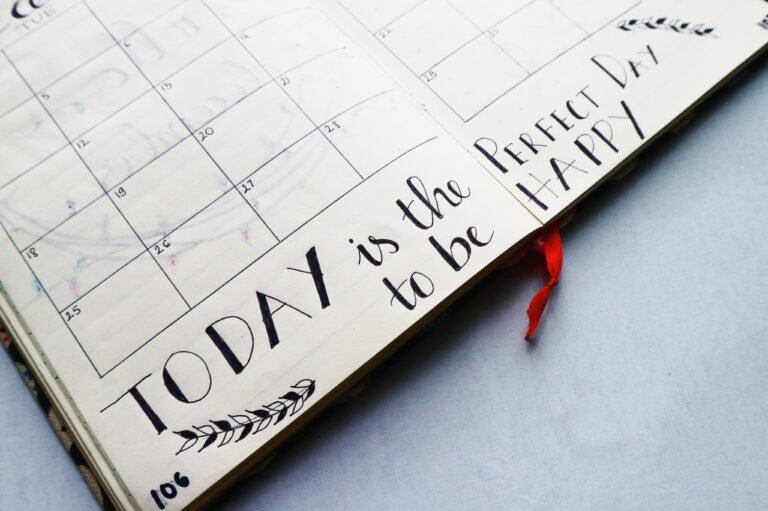Create a Daily Routine Bullet Journal
If you’re looking to organize your day and stay on top of your tasks, a Daily Routine Bullet Journal might just be the solution for you. This helpful tool allows you to track your daily activities, set goals, and prioritize tasks, all in one place.
Whether you’re a busy professional, a parent juggling multiple responsibilities, or simply someone looking to improve their time management skills, a Daily Routine Bullet Journal can provide structure and support. In this article, we will explore the benefits of using a bullet journal from a Catholic perspective and how it can enhance your daily routine. So, grab a pen and get ready to discover the power of organization and intentionality in your life.
Benefits of Using a Daily Routine Bullet Journal
Track and prioritize your tasks
A daily routine bullet journal allows you to track and prioritize your tasks effectively. By writing down your to-do list and organizing it in your journal, you can easily see what needs to be done and in what order. This helps prevent tasks from getting overlooked or forgotten, and ensures that you are able to tackle the most important tasks first.
Improve time management
One of the key benefits of utilizing a daily routine bullet journal is the improvement in time management. With a clear overview of your schedule and tasks, you can allocate your time more efficiently. You can set realistic deadlines, allocate time slots for each task, and avoid overcommitting yourself. By managing your time effectively, you can become more productive and accomplish more in your day.
Increase productivity
Using a daily routine bullet journal can significantly increase your productivity. The act of writing down your tasks and goals helps you to focus and gives you a sense of direction. As you check off completed tasks and see your progress, you’ll feel a sense of accomplishment and motivation to keep going. The structure and organization of a bullet journal can help you stay on track and avoid distractions, ultimately increasing your overall productivity.
Develop healthy habits
A daily routine bullet journal can also aid in the development of healthy habits. By incorporating habits into your journal, such as exercise, meditation, or drinking enough water, you can track your consistency and progress. Seeing your habits visually represented in your journal can be a powerful motivator and reminder to stay committed to your health and well-being.
Reduce stress and anxiety
Maintaining a daily routine bullet journal can be a helpful tool in reducing stress and anxiety. By planning and organizing your tasks ahead of time, you can minimize the feeling of being overwhelmed. The act of writing down your thoughts and to-do lists can also provide a sense of clarity and help you feel more in control. Additionally, the practice of reflecting on your progress and accomplishments can boost your mood and reduce feelings of stress and anxiety.
Getting Started with a Daily Routine Bullet Journal
Choose the right journal
The first step in getting started with a daily routine bullet journal is choosing the right journal for your needs. Consider the size, paper quality, and binding of the journal. Some people prefer smaller journals that are easy to carry around, while others prefer larger ones with more space for creativity. Look for a journal that suits your preferences and feels comfortable to use.
Create a key or legend
Creating a key or legend is essential in a bullet journal. This is a system of symbols, icons, and colors that you will use to categorize and label your tasks and events. For example, you may use a bullet point to represent tasks, a star to represent important events, and a checkmark to indicate completed tasks. Establishing these symbols and colors will help you quickly understand and navigate your journal.
Set up your index
The index is a table of contents for your journal and is crucial for easy reference. Allocate a few pages at the beginning of your journal for the index. As you add new sections or pages, make sure to update the index accordingly. This will make it easier to find specific information or pages within your journal.
Plan your daily layout
Designing your daily layout is an important step in a bullet journal. This layout will serve as the foundation for your daily planning and organization. Consider how much space you need for your tasks, events, and notes. Some people prefer to have a structured layout with specific sections, while others opt for a more flexible and minimalistic approach. Experiment with different layouts until you find one that works best for you.
Consider weekly spreads
In addition to the daily layout, you may want to consider incorporating weekly spreads in your bullet journal. This allows you to have a broader view of your week and helps with long-term planning. You can include an overview of your goals for the week, important events, and any specific tasks or deadlines. Weekly spreads can help you stay focused and prevent tasks from falling through the cracks.
Decide on monthly overviews
Monthly overviews are another useful addition to a daily routine bullet journal. They provide a comprehensive view of your entire month, allowing you to plan ahead and set monthly goals. Include important dates, events, and deadlines in your monthly overview. This will help you see the bigger picture and assist you in allocating your time and resources effectively.

Establishing a Daily Routine
Define your goals and priorities
Before diving into your daily routine bullet journal, take some time to define your goals and priorities. What do you want to achieve in various aspects of your life, such as work, personal growth, relationships, or health? By identifying your goals, you can align your daily routine with what truly matters to you. This will give your journaling purpose and assist in structuring your days accordingly.
Identify must-do tasks
Once you have a clear sense of your goals and priorities, identify the must-do tasks that align with them. These are the tasks that are crucial for your success and should be prioritized in your daily routine. By focusing on these tasks, you can make progress towards your goals and prevent them from being overshadowed by less important tasks.
Create a morning routine
Designing a morning routine in your daily routine bullet journal can set the tone for a productive and positive day. Consider what activities or habits you want to incorporate into your morning routine to jumpstart your day. This could include meditation, exercise, journaling, or reading. By creating a morning routine and documenting it in your journal, you can commence each day with intention and purpose.
Design an evening routine
Just as important as a morning routine is an evening routine. Your evening routine sets the stage for a restful night and prepares you for the following day. Decide on activities that promote relaxation and help you wind down from the day’s events. This could include reading, practicing gratitude, or engaging in a creative outlet. With a well-designed evening routine, you can end your day on a positive note and promote better sleep.
Incorporate self-care activities
Self-care is a crucial component of a daily routine bullet journal. Include activities that nurture your well-being and help you recharge. This could be as simple as taking a walk in nature, practicing mindfulness, or indulging in a hobby you love. By prioritizing self-care and documenting it in your journal, you can ensure that you make time for activities that bring you joy and relaxation.
Schedule time for leisure and hobbies
It’s important to schedule time for leisure and hobbies in your daily routine bullet journal. Your journal shouldn’t just be focused on work or tasks, but also on activities that bring you pleasure and fulfillment. Allocate time for activities such as reading, painting, playing an instrument, or spending time with loved ones. By incorporating leisure and hobbies into your routine, you can maintain a healthy work-life balance.
Designing Layouts and Modules
Utilize habit trackers
Habit trackers are a valuable tool in a daily routine bullet journal. They allow you to visually track your habits over time, helping you stay accountable and motivated. Create a habit tracker in your journal by listing the habits you want to cultivate and marking off each day you successfully complete them. Habit trackers can help you establish consistency and make progress towards your goals.
Include gratitude journaling
Gratitude journaling is a powerful practice to incorporate into a daily routine bullet journal. Take a few moments each day to reflect on and write down three things you are grateful for. This practice shifts your focus to the positive aspects of your life and cultivates a mindset of gratitude. By including gratitude journaling in your journal, you can foster greater contentment and happiness.
Implement meal planning
Meal planning is another useful module for a daily routine bullet journal, especially for those who want to maintain a healthy diet or are working towards specific health goals. Dedicate a section in your journal for meal planning where you can jot down your meals for the week, create a shopping list, or write down new recipes to try. By incorporating meal planning into your routine, you can save time, reduce stress, and make healthier choices.
Incorporate exercise and fitness tracking
For those striving to improve their physical fitness, incorporating exercise and fitness tracking modules in your daily routine bullet journal can be beneficial. Set goals for physical activity and track your progress in your journal. This could be as simple as logging your daily steps, tracking your workouts, or recording your personal records. By documenting your fitness journey, you can stay motivated and see your progress over time.
Track sleep patterns
Tracking your sleep patterns can provide valuable insights into your overall well-being. Include a sleep tracker in your daily routine bullet journal to record the duration and quality of your sleep each night. This information can help you identify patterns and make adjustments to improve your sleep hygiene. By prioritizing sleep and monitoring your patterns, you can enhance your overall health and well-being.
Organize your to-do lists
To-do lists are a fundamental component of a daily routine bullet journal. Keep your tasks organized and easily accessible by creating a dedicated space for to-do lists in your journal. You can use bullets, checkboxes, or other symbols to indicate the status of each task. By having a structured and organized system for your to-do lists, you can stay focused and avoid feeling overwhelmed.
Maintaining Consistency
Make it a daily habit
To fully reap the benefits of a daily routine bullet journal, it’s important to make it a daily habit. Incorporate journaling into your daily routine, whether it’s in the morning or evening, and commit to doing it consistently. Consistency is key to developing a sense of structure and organization in your life. Aim to make your journaling practice a non-negotiable part of your routine.
Use reminders and alarms
If you struggle with remembering to journal daily, use reminders and alarms to prompt you. Set up notifications on your phone or use a physical reminder, such as placing your journal in a visible location. By incorporating reminders into your daily life, you can establish a routine and ensure that you don’t forget to journal.
Stay flexible and adaptable
While it’s important to maintain consistency, it’s also essential to stay flexible and adaptable with your daily routine bullet journal. Life can be unpredictable, and there will be days when you might not be able to journal as planned. Embrace these challenges and find alternative ways to adapt your journaling practice. This could be through modified layouts, shorter journaling sessions, or simply using your journal as a tool for reflection when needed.
Review and reflect on your progress
Regularly review and reflect on your progress in your daily routine bullet journal. Set aside time periodically to assess your goals, habits, and routines. Are you making progress toward your goals? Have you been consistent with your habits? What adjustments can you make to improve? Use your journal as a tool for self-reflection and growth, and make any necessary changes to ensure continuous improvement.
Make adjustments as needed
Don’t be afraid to make adjustments to your daily routine bullet journal as needed. If certain modules or layouts aren’t working for you, experiment with different approaches until you find what works best. Your journal should evolve and adapt along with your needs and priorities. Be open to trying new techniques or modifying existing ones to optimize your journaling experience.
Seek accountability and support
If you find it challenging to maintain consistency, seek accountability and support. Share your bullet journaling journey with a friend or join an online community where you can connect with others who have similar interests. Accountability partners and support networks can provide motivation, inspiration, and guidance as you navigate your daily routine bullet journal.
Tips and Techniques for Effective Bullet Journaling
Use symbols and icons
Symbols and icons can be powerful tools in your daily routine bullet journal. Develop a system of symbols and icons that makes sense to you and helps you navigate your journal more efficiently. For example, you may use a star for important tasks, a exclamation mark for urgent tasks, or a heart for self-care activities. Consistently using symbols and icons will make your journaling process more intuitive.
Experiment with different layouts
Don’t be afraid to experiment with different layouts in your bullet journal. There are countless layout ideas available online, ranging from minimalist to artistic and intricate designs. Try out different formats and styles to find what resonates with you. Your journal is a reflection of your personality and preferences, so have fun and be creative with your layouts.
Color code your entries
Color coding is a useful technique for organizing and categorizing your entries. Assign specific colors to different categories or themes in your journal. For example, use different colors for work-related tasks, personal goals, or self-care activities. Color coding allows for easy visual differentiation and helps you quickly locate information within your journal.
Practice mindfulness while journaling
When journaling, try to practice mindfulness and be fully present in the moment. Use your journaling time as an opportunity to reflect on your thoughts, emotions, and experiences. Pay attention to your surroundings and the physical act of writing. Incorporating mindfulness into your journaling practice can enhance self-awareness and promote a deeper connection with yourself.
Avoid overwhelming yourself with tasks
It’s essential to avoid overwhelming yourself with an excessive number of tasks in your daily routine bullet journal. Be realistic with your planning and prioritize tasks that truly matter. Overburdening yourself can lead to stress and burnout. Focus on quality rather than quantity, and be kind to yourself if you don’t complete everything on your list. Remember that progress is more important than perfection.
Celebrate achievements and milestones
Take the time to celebrate your achievements and milestones in your daily routine bullet journal. Whether it’s completing a difficult project, reaching a fitness goal, or developing a new habit, acknowledge and appreciate your progress. This boosts your confidence and motivation to continue your journey. Include a dedicated section in your journal to record and celebrate these accomplishments.
Finding Inspiration and Ideas

Explore online bullet journal communities
The internet offers a wealth of inspiration and ideas for your daily routine bullet journal. Explore online bullet journal communities and forums where you can connect with fellow journaling enthusiasts. Share your own ideas and learn from others’ experiences. Engaging with an online community can provide fresh perspectives, new techniques, and endless inspiration for your journaling practice.
Follow bullet journal influencers and accounts
Follow bullet journal influencers and accounts on social media platforms such as Instagram or Pinterest. These individuals often share tips, tutorials, and inspiration for bullet journaling. You can gain insights into different layouts, module ideas, and creative approaches. Adapt and customize their ideas to fit your own unique style and needs.
Participate in challenges and prompts
Engage in bullet journal challenges and prompts to spark creativity and explore new themes or ideas. Many online communities host monthly or weekly challenges that provide prompts and themes for each day or week. Participating in these challenges can help you diversify your journaling practice and push the boundaries of your creativity.
Adapt and customize ideas to fit your needs
While exploring online resources and communities, adapt and customize ideas to fit your own needs and preferences. Everyone’s daily routine is unique, so it’s essential to tailor your journaling practice accordingly. Modify layouts, tweak modules, or combine different techniques to create a personalized routine that resonates with you.
Collect inspiration from magazines and books
If you prefer a more tangible source of inspiration, consider collecting ideas from magazines or books about journaling, mindfulness, or personal development. Browse through magazines or check out books that showcase different bullet journaling techniques, layouts, or themes. Taking inspiration from these sources can spark creativity and lead to innovative ideas for your own journaling practice.
Attend workshops or classes
Another way to find inspiration and ideas for your daily routine bullet journal is to attend workshops or classes. Look for local events or online courses that focus on bullet journaling or related topics. These workshops often provide hands-on guidance, expert advice, and opportunities to connect with like-minded individuals. Attending workshops or classes can expand your knowledge and inspire new directions for your journaling practice.
Incorporating Faith in Your Daily Routine Bullet Journal
Include prayers and reflections
If you would like to incorporate your faith into your daily routine bullet journal, consider including prayers and reflections. Set aside a section in your journal where you can write down prayers, meaningful quotes, or passages from religious texts. This can serve as a source of inspiration and provide a space for spiritual reflection and connection.
Design faith-based trackers
Design faith-based trackers to monitor your spiritual practices or commitments. This could include tracking daily prayers, acts of service, or scripture reading. By incorporating these trackers into your journal, you can stay accountable to your spiritual goals and deepen your faith.
Document Bible verses or spiritual quotes
Include sections in your daily routine bullet journal to document Bible verses or spiritual quotes that resonate with you. Write down verses or quotes that inspire and uplift you, and reflect on their meaning. This practice can serve as a source of guidance and encouragement throughout your day.
Create a gratitude section for spiritual blessings
In addition to general gratitude journaling, create a dedicated section in your bullet journal for expressing gratitude for spiritual blessings. Reflect on the ways in which your faith has enriched your life and write down specific blessings or answered prayers. Cultivating a sense of gratitude for your spiritual journey can deepen your connection with your faith.
Incorporate devotional or meditation practices
Consider incorporating devotional or meditation practices in your daily routine bullet journal. Allocate specific time in your daily or weekly layout for meditation, scriptural readings, or other spiritual practices. Document your experiences and reflections in your journal to create a chronicle of your spiritual growth.
Track spiritual goals and progress
Track your spiritual goals and progress in your daily routine bullet journal. Set intentions for personal growth in your faith and actively work towards them. Utilize trackers or specific journaling prompts to record your progress and evaluate areas for further development. By documenting your spiritual journey, you can stay focused and motivated in your faith.
Troubleshooting Common Challenges
Feeling overwhelmed or disorganized
If you find yourself feeling overwhelmed or disorganized with your daily routine bullet journal, take a step back and reassess your approach. Simplify your layouts, streamline your modules, or reduce the number of tasks you include. Focus on the essentials and eliminate any unnecessary complexity. Remember that your journal should serve as a tool to support your well-being, not add to your stress.
Lack of motivation or consistency
If you struggle with a lack of motivation or consistency, remind yourself of the benefits that come with regularly using your bullet journal. Reflect on the progress you’ve made, the sense of accomplishment you feel when you complete tasks, and the positive impact journaling has on your life. Find inspiration from others, set achievable goals, and reward yourself for staying consistent.
Dealing with perfectionism
Perfectionism can hinder your daily routine bullet journaling practice. Remember that your journal doesn’t have to be perfect. Accept that mistakes and imperfections are part of the journey. Embrace the process of growth and self-discovery, rather than striving for flawless execution. Allow yourself to experiment, make adjustments, and learn along the way.
Finding time to journal daily
Finding time to journal daily can be a challenge, especially when faced with a busy schedule. Consider allocating a specific time slot each day dedicated to journaling. This could be in the morning, during a lunch break, or in the evening before bed. Treat your journaling time as a non-negotiable appointment with yourself, and prioritize it just like any other important commitment in your day.
Managing different areas of life

Balancing different areas of life can be a challenge when journaling. To manage this, create separate sections or modules in your daily routine bullet journal for work, personal life, health, and other important aspects. Dedicate specific time to each area and ensure that you’re allocating enough attention and effort to maintain a well-rounded daily routine.
Avoiding burnout or exhaustion
To avoid burnout or exhaustion, be mindful of your energy levels and self-care practices. Pay attention to your physical and emotional well-being. Incorporate activities that nourish and rejuvenate you into your daily routine. Pace yourself, set realistic expectations, and understand that rest and relaxation are essential components of productivity and overall well-being.
Conclusion
Embracing a daily routine bullet journal offers a multitude of benefits, ranging from improved time management to reduced stress and increased productivity. By tracking and prioritizing your tasks, developing healthy habits, and incorporating self-care, you can enhance your daily life and work towards your goals. Remember to maintain a consistent journaling practice, stay open to adjustments and inspiration, and make your journaling journey a personal one. With a daily routine bullet journal, you can enjoy the process and reap the rewards of a more organized, intentional, and fulfilled life.






